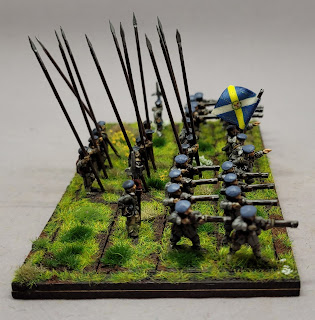The Kingdom Is Ours
We should be used to 28mm Civil War figure manufacturers publishing their in-house rules, Warlord's Pike and Shotte, Foundry's 1644. The Kingdom is Ours is Bicorne's foray into rules publishing. Whilst it is to be expected that these rulebooks become glossy showrooms for their figure ranges, The Kingdom Is Ours has a stronger whiff of it being Bicorne's catalogue with some rules tacked on, rather than a set of rules that showcase figures from a particular range.
As appears standard, there is a very brief timeline and introduction to troop types encountered in English Civil War battles. |
| The ever splendid Peter Dennis providing the cover artwork |
Then follows an explanation of the 'unit trackers', a frame to hold a number of dice (10 D6 per tracker). And yes you are going to need one for each unit. Coincidentally, or not, these are for sale on Bicorne's website. You will also need a command tracker for each general (just 5 D6 for these). Shares in a D6 company might come in handy.
By the time we get to p21 we finally get to see the 'Bicorne fast play rules', all pretence that the rules are called 'The Kingdom Is Ours' has now been dropped.
Lots of pregame setup, for each unit you roll 2D6 to establish the unit's quality. The ability of the commander is also diced for; the better quality he is, the more commands he can issue each turn.
Turn order is dictated by random dice selection (40D6 of the same size are put into a dice pot/bag; each side having a different colour so 20 red D6 for Royalists, 20 orange for Parliament for example). There is no breakdown of a 'turn' into movement, fire, morale, casualty phases. When a side's coloured dice is drawn, an order can be given to a unit. Orders can be given to a unit directly, or by a commander (the unit must be in his Command Radius). The order can be given to any unit, and a unit can be given up to three orders per 'turn'.
Movement is dependent on the total on a number of d6, 2 for infantry, 3 if charging; 4 for cavalry5 if charging. This leads to difficulty trying to co-ordinate an attack. Units outside the command radius of the general will need to roll to see if they receive the order, with only one commander this can lead to some units failing to move. Once the dice to end the turn is drawn, action ceases and then the 'random events' phase starts. A roll of 9 or 0 on a D10 initiates a 'random event': two d10 are thrown and the total checked against an events table. Some events are positive, other less so.
Combat is a two or three three stage process: establish a possible hit, casualties inflicted, for mixed units is it pike or shot?
 |
| Just one of the pages of the quick play sheet |
Okay, familiarity would speed things up considerably, but there are quite a lot of tables to check for various phases slowing things down. The quick play sheet runs to 5 pages, a detachable or separate quick play sheet is not included, nor have I found an 'official' one for download.
Lots of pictures of beautiful figures, but the whole thing comes across as a Bicorne catalogue.
Whilst trackers could easily be made on a computer, laminated and utilise dry wipe pens rather than Bicorne's trackers and dice, that's are a lot of time and effort to invest to see if it works for you.
Equipment needed:
Equipment needed:
- tape measure
- 1 purple D6 (the dice of doom)
- at least 20D6 per side (each 'set' the same size and colour)
- D10 for morale
- a dice pot or bag
- unit trackers - one for each unit
- command tracker - one per commander
- gazillions of different coloured dice for casualties/ammo/status markers (10 D6 required for each unit tracker, 5 D6 for the command tracker))
- different coloured (again) D6 for combat
- a protractor
If you enjoyed reading this, or any of the other posts, please consider supporting the blog.
Thanks.












Comments
Post a Comment